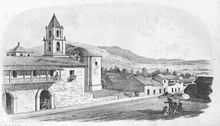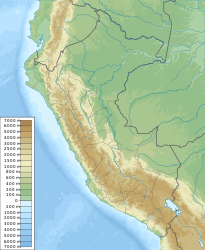Huanta
| Huanta | |||
|---|---|---|---|
|
|
|||
| Coordinates | 12 ° 56 ′ S , 74 ° 15 ′ W | ||
| Symbols | |||
|
|||
| Basic data | |||
| Country | Peru | ||
| Ayacucho | |||
| province | Huanta | ||
| ISO 3166-2 | PE-AYA | ||
| District | Huanta | ||
| height | 2627 m | ||
| Residents | 31,757 (2017) | ||
| founding | November 22, 1905 | ||
| Website | www.munihuanta.gob.pe (Spanish) | ||
| politics | |||
| mayor | Renol Silbio Pichardo Ramos (2019-2022) | ||

Huanta , in Chanka-Quechua Wanta is the capital of the Huanta Province in the far north of the Ayacucho region as well as the administrative seat of the Huanta District .
Huanta is 25 km as the crow flies and 47.7 km by road north of the regional capital Huamanga (Ayacucho) at an altitude of 2,627 m above sea level (msnm) and has a moderately warm climate. With 31,757 inhabitants (2017 census), Huanta is the second largest city in the Ayacucho region after Huamanga. Ten years earlier, the population was 26,026.
Huanta is known for the student rebellion of 1969 against the introduction of tuition fees by the Juan Velasco Alvarado government , in which at least 20 people were killed by the Sinchis paratrooper police unit , but which led to the decree being withdrawn. Shortly afterwards , Professor Ricardo Dolorier Urbano (* 1935), who came from here, wrote the song “Flor de Retama” in memory of the events.
Huanta is one of the cities where most people died during the armed conflict in Peru in the 1980s and 1990s. According to the Commission for Truth and Reconciliation registered eyewitness accounts 47.4% of the named registered deaths from Ayacucho and of these about half were - 5,186 deaths and " disappearances " - in the provinces of Huanta and La Mar .
Born in Huanta
- Porfirio Meneses Lazón (1915–2009), Peruvian Quechua writer
- Federico Richter Fernandez-Prada (1922–2011), Peruvian priest
- Magaly Solier Romero (* 1986), Peruvian actress, poet and singer
Web links
Individual evidence
- ↑ Text examples: César Itier: Literatura nisqap qichwasimipi mirayñinmanta , AMERINDIA n ° 24, 1999; Sumaq kawsay - Kuskanchik yachasunchik, 4i ( Memento of the original from January 2, 2017 in the Internet Archive ) Info: The archive link was inserted automatically and has not yet been checked. Please check the original and archive link according to the instructions and then remove this notice. . Perú Suyupi Yachay Kamayuq, Lima 2015, p. 48; Sumaq kawsay - Kuskanchik yachasunchik, 6i ( Memento of the original from January 2, 2017 in the Internet Archive ) Info: The archive link was inserted automatically and has not yet been checked. Please check the original and archive link according to the instructions and then remove this notice. . Perú Suyupi Yachay Kamayuq, Lima 2015, p. 57.
- ^ Huanta, Province in Ayacucho Region, Urban Main Locality . www.citypopulation.de. Retrieved November 18, 2019.
- ^ Roger Saravia Avilés: Rebelión en Huanta, Junio de 1969 . Universidad Nacional de Educación Enrique Guzmán y Valle "La Cantuta", Lima 2007.
- ↑ Abilio Vergara: La tierra que duele de Carlos Falconí : Cultura, musica, identidad y violencia en Ayacucho. Capítulos IV + V, pp. 139-222. Capítulo IV. La Tierra que duele de Carlos Falconí. La historia de la violencia en la canción popular , pp. 139–169, here p. 152. Universidad Nacional de San Cristóbal de Huamanga. Ayacucho, 2010.
- ↑ María Elena Castillo Hijar: Huanta, un pueblo que busca cerrar sus heridas . La República, February 9, 2015.


